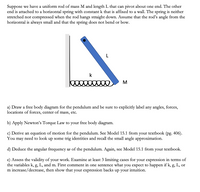Question
Please Part D and E only

Transcribed Image Text:Suppose we have a uniform rod of mass M and length L that can pivot about one end. The other
end is attached to a horizontal spring with constant k that is affixed to a wall. The spring is neither
stretched nor compressed when the rod hangs straight down. Assume that the rod's angle from the
horizontal is always small and that the spring does not bend or bow.
M
a) Draw a free body diagram for the pendulum and be sure to explicitly label any angles, forces,
locations of forces, center of mass, etc.
b) Apply Newton's Torque Law to your free body diagram.
c) Derive an equation of motion for the pendulum. See Model 15.1 from your textbook (pg. 406).
need to look up some trig identities and recall the small angle approximation.
You
may
d) Deduce the angular frequency w of the pendulum. Again, see Model 15.1 from your textbook.
e) Assess the validity of your work. Examine at least 3 limiting cases for your expression in terms of
the variables k, g, L, and m. First comment in one sentence what you expect to happen if k, g, L, or
m increase/decrease, then show that your expression backs
up your
intuition.
Expert Solution
This question has been solved!
Explore an expertly crafted, step-by-step solution for a thorough understanding of key concepts.
This is a popular solution
Trending nowThis is a popular solution!
Step by stepSolved in 3 steps with 1 images

Knowledge Booster
Similar questions
- Answer b, c and d with unitsarrow_forwardPlease help with C and Farrow_forwardA charge of -3.25 nC is placed at the origin of an xy- coordinate system, and a charge of 2.30 nC is placed on the y axis at y = 4.40 cm. If a third charge, of 5.00 nC, is now placed at the point x = 3.50 cm, y = 4.40 cm find the x and y components of the total force exerted on this charge by the other two charges. Express answers numerically separated by a comma. Fa, Fy = Part B Find the magnitude of this force. F = N Narrow_forward
arrow_back_ios
arrow_forward_ios